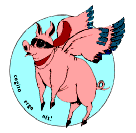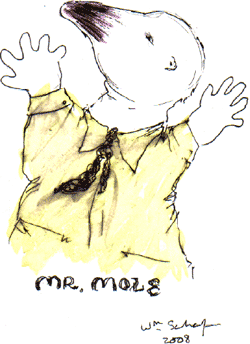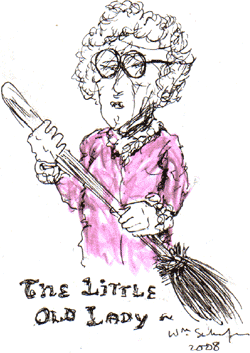| The Journal of Provincial Thought |
|
 |
|||||||||||||||
| A NARRATIVE TOLD TO A SONY MODEL TC-252 TAPECORDER By Amelia Anne Schafer, age 7, as slightly edited & typographically arranged by William J. Schafer, age 33 ________________________________________________ |
||||||||||||||||
|
A NOTE ON THE MOLE STORIES: The Mole stories are an old stew tradition in my wife’s family. Amy’s grandmother invented the saga of Mr. Mole & the Little Old Lady as an inducement to her children to eat their stew. The series, as originally recited, always centered on a giant, delicious stew full of turnips, carrots, potatoes, etc., which the Old Lady perpetually cooked. Mr. Mole was an Autolycus (to mix moles & wolves) in pursuit of this stew. Inevitably he attempted to hijack the stew & inevitably the Old Lady caught him & thrashed him with her sturdy broom. The epic was functional in design: descriptions of hot, delicious stew + roguish adventures = listening children who would willingly eat their own hot stew as the tale unfolded. We have continued the Mole Saga in our branch of the family, & Amy has grown up on the simple & repetitious stories. Her own variations occur away from the dinner table, so Amy has (logically) removed the traditional central interest, the eternal stew. She sees the Mole family & the Little Old Lady as autonomous characters free of their original mythic functions. The stories deal with methods of retribution and punishment (“Mr. Mole”) and of child-rearing (“Mr. Mole & His Little Child Timmy”). Things happen rapidly & without much sense of continuity or transition, with scenes shifting & characters hopping around as wildly as in the incomparable Krazy Kat cartoons. Everything for en effect, everything in the interest of the action—that’s Amy’s method, and God help Aristotle! She is quite consistent in the way she sees her characters, even if they are inconsistent & violent themselves. I guess that’s the way it is when you are seven.
She runned back home & then the next time she came they all were in the fort.They were all ready. She said, “I’m not ready.” She runned back home & slept in her rocking chair with 41 covers over her & 1 fire. 3 electric ones & 32 not-electric ones. And she was sleeping & sleeping & sleeping & they got some butter & some salt & all that. Well! they carried her & carried her & carried her until they got to their fort & they walked in. They put her there, put on some jamas for her & put on her nightcap & such a thing. They slept till the next morning & she woke up angry at them & then they bringed her in the house. She was sooo sleepy. So sleepy that she just plopped down on their couch. It was made out of straw. She wiggled around & wiggled until she woke up & was VERY furious— furiouser than she was! She went: POOO! I DO NOT LIKE SLEEPING ON A STRAW MAT! Well then they covered some dirt over her, packed it good, put those covers over her & then they got her pillow she was using. She said, “That’s MUCH better!” She went back to sleep. ZONK! ZONK! ZONK! “I don’t like that noise,” said Mrs. Mole. “I don’t like it either,” said the 2 boys & 1 girl & Ted. “We don’t like it at all, so would you shut up? You’re one of our enemies & we’ve got you trah-apped!” Well, they carried her back to the house. She was ZONK! ZONK! ZONK! at her house. She liked it. She didn’t care if she sleeped like that. Then her husband came back in & went “SHUT UP!” Well, she said, “At least you don’t snore anymore. Go to sleep. You may, if you don’t snore.” Well, she went gzzzble gzzzble until she went ZONK! ZONK! & he said, “Shut up! For the last time, I’d like to say it!” * THAT’S ALL *
MR. MOLE & HIS LITTLE CHILD TIMMY
Once upon a time there was this little cabin & across from the cabin was a meadow of crops—you know what crops are, don’t you? And right in the middle of the crop field there was a hole. And there was a mole who lived in that hole & his name was Mr. Mole. He had a wife-mole, 2 boys & 1 girl. Susan, Tom & Joe were the children. Susan was the girl, Tom & Joe was the two boys. Mr. Mole’s name was Tommy Mole, but they called him Mr. Mole. The mother was Tina Mole. The Old Lady—well, she had a husband & they played. The children played all day. One day Joe decided he would be with Father, helping him beat up the Old Lady & her poodle that she had. Well the poodle one day came along when Tom was pulling up crops. He threw 2 or 3 crops at him. The dog bringed a bag of potatoes to throw at him, but he dropped them by accident. Then Tom & Joe caught him & said, “Now you’re in for it!” & threw them at him. He came home & the Old Lady was furious. She was furious &—whooo! she really was mad! She shouted, “Oh, you little old pinko! Ah!” And she went upstairs & got a little tub for him & was ready to wash him, you know, like most people wash their dogs. Well, she had tomato soap to wash tomatoes, but she used it on him to wash off the tomatoes. And she put flea soap on him. Well, the dog Arf Arf Arf with the tomato soap on him—arfarfarf—then it stinged because it got in his eyes. He went . . . he blinked & he blinked: 2 times, 3. 4, 50, 60, 70, 80. Well, that was all. He just sat down in the tub & slept & slept & slept & slept & slept & slept. He woke up & he was under his cover with his little coat on in his little house with his little hat. And he went outside to take a walk with her. They took a walk & Mrs. Mole had a new little baby & they named him Timmy Timmy Timmy. Timmy Little Mole. Timmy was 5 weeks old now. He played around outside. He would play with the turnips, he would play with the crops. He would play with all that he could get his hands on. “He had to learn about nature,” one day said Mother. So he did. He learned. He learned how to hunt. He learned how to get the Old Lady. By one chance, that’s what he did one day: hit her with a turnip. Mama was glad & proud of Timmy. And she liked it. Timmy said, “Goody goody goody goody” & threw one at Mama. She said, “bad boy.” He said, “You bad girl.” She said, “Bad bad.” “Bad bad Mama.” “Go to bed.” “Go to bed, Mama.” Well, Timmy went & played with the turnips & the crops & the tomatoes & * THAT’S ALL *
Afterword (1976)
Four years later, Amy is still at work on dictated stories. Now they are much more sophisticated & “literary.” She likes to tell mystery stories, something on the order of Agatha Christie’s tales of genteel lives and tragic conflicts. They are full of foreshadowings, climaxes, reversals, denouements & all that other Aristotelian stuff. She is more self-conscious than she used to be, but her stories are still very original. Our family has kept up a tradition of reading aloud—everything from J.R.R. Tolkien, C.S. Lewis, Conan Doyle, Daniel Defoe, to Herman Melville and Dean Swift. So Amy has a sense of literature as an oral (& aural) art, & the voice comes for her before the pen. This has been a salvation for a girl seemingly doomed not to read. She has embarked on undertakings more ambitious & complex than these Mole stories, but I think her first efforts are as fresh & imaginative as anything she is likely to do. The mythic qualities here, the weaving of a family collective folktale by an individual imagination are part of Amy’s artistic growth. She may go on to be a poet as we know the trade, but she will never be any closer to the sources of art. Afterafterword (2008)
Amelia did not become a poet or a professional writer. She did keep a detailed journal for years and years, piling up a ziggurat of blank books she loved buying and filling. She told her journal stories about her adventurous life—traveling with a friend to Britain at age 16, sleeping in ditches (or once on straw in the stables of a posh prep school in Northumberland), going later to Britain to be an apprentice hatmaker and a nanny, then on to Italy and Spain, in a small motorcycle accident on Corfu, staying in a luxury apartment on the Champs d’Elysees then deciding to go to university and working through four years for a degree in anthropology. Then a humanities degree from ### |
||||||||||||||||
|
||||||||||||||||
| Copyright 2009- WJ Schafer & WC Smith - All Rights Reserved | ||||||||||||||||

